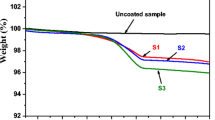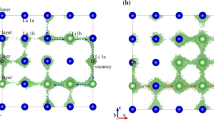Abstract
To prepare an anode material for Li-ion batteries with high discharge capacity and good cycling stability, disordered carbon (DC) formed by calcinations of 3,4,9,10-perylenetetracarboxylic dianhydride was modified via an acid treatment using a mixture of HNO3 and H2SO4. The modified disordered carbon (MDC) was characterized by Fourier-transform infrared (FTIR) spectroscopy, X-ray diffraction (XRD) analysis, Brunauer-Emmett-Teller (BET) analysis, and scanning electron microscopy (SEM). FTIR spectra confirm the successful introduction of carbonyl groups onto the DC surface. Some pores appear in the columnar structure of MDC, as observed in SEM micrographs. Li+ ions intercalation/deintercalation is facilitated by the modified morphology. Electrochemical tests show that the MDC exhibits a significant improvement in discharge capacity and cycling stability. These results indicate that the MDC has strong potential for use as an anode material in Li-ion batteries.
Similar content being viewed by others
References
L. Chen, X.L. Li, Q. Zhao, W.B. Cai, and Z. Y. Jiang, Bipolar pulse current charge method for inhibiting the format ion of lithium dendrite, Acta Phys. Chim. Sin., 22(2006), No. 9, p. 115.
M.S. Whittingham, Chalcogenide Battery, US Patent, Appl. US4009052 A, 1977.
J.H. Jeong, D.W. Jung, E.W. Shin, and E.S. Oh, Boron-doped TiO2 anode materials for high-rate lithium ion batteries, J. Alloys Compd., 604(2014), p. 226.
P.C. Lian, J.Y. Wang, D.D. Cai, G.X. Liu, Y.Y. Wang, and H.H. Wang, Design and synthesis of porous nano-sized Sn@C/graphene electrode material with 3D carbon network for high-performance lithium-ion batteries, J. Alloys Compd., 604(2014), p. 188.
P.P. Lv, H.L. Zhao, Z.P. Zeng, J. Wang, T.H. Zhang, and X.W. Li, Facile preparation and electrochemical properties of carbon coated Fe3O4 as anode material for lithium-ion batteries, J. Power Sources, 259(2014), p. 92.
D.S. Wang, M.X. Gao, H.G. Pan, Y.F. Liu, J.H. Wang, S.Q. Li, and H.W. Ge, Enhanced cycle stability of micro-sized Si/C anode material with low carbon content fabricated via spray drying and in situ carbonization, J. Alloys Compd., 604(2014), p. 130.
K.Q. Wu, X.T. Lin, L.Y. Shao, M. Shui, N.B. Long, Y.L. Ren, and J. Shu, Copper/carbon coated lithium sodium titanate as advanced anode material for lithium-ion batteries, J. Power Sources, 259(2014), p. 177.
J. Yi, Y.L. Liu, Y. Wang, X.P. Li, S.J. Hu, and W.S. Li, Synthesis of dandelion-like TiO2 microspheres as anode materials for lithium ion batteries with enhanced rate capacity and cyclic performances, Int. J. Miner. Metall. Mater., 19(2012), No. 11, p. 1058.
Y.B. Chen, Y. Hu, F. Lian, and Q.G. Liu, Synthesis and characterization of spinel Li1.05Cr0.1Mn1.9O4−z Fz as cathode materials for lithium-ion batteries, Int. J. Miner. Metall. Mater., 17(2010), No. 2, p. 220.
S. Yata, H. Kinoshita, M. Komori, N. Ando, T. Kashiwamura, T. Harada, K. Tanaka, and T. Yamabe, Structure and properties of deeply Li-doped polyacenic semiconductor materials beyond C6Li stage, Synth. Met., 62(1994), p. 153.
K. Sato, M. Noguchi, A. Demachi, N. Oki, and M. Endo, A mechanism of lithium storage in disordered carbons, Science, 264(1994), No. 5158, p. 556.
Y. Nishi. Organic Electrolyte Secondary Cell, EU Patent, Appl. 89115940.2, 1996.
M. Alamgir, Q. Zuo, and K.M. Abraham, The behavior of carbon electrodes derived from poly(p-phenylene) in polyacrylonitrile-based polymer electrolyte cells, J. Electrochem. Soc., 141(1994), No. 11, p. L143.
Z.H. Yi, X.Y. Han, C.C. Ai, Y.G. Liang, and J.T. Sun, Reversible lithium intercalation in disordered carbon prepared from 3,4,9,10-perylenetetracarboxylic dianhydride, J. Solid State Electrochem., 12(2008), No. 9, p. 1061.
J. Kong, N.R. Franklin, C. Zhou, M.G. Chapline, S. Peng, K. Cho, and H. Dai, Nanotube molecular wires as chemical sensors, Science, 287(2000), No. 5453, p. 622.
P.G. Collins, K. Bradley, M. Ishigami, and A. Zettl, Extreme oxygen sensitivity of electronic properties of carbon nanotubes, Science, 287(2000), No. 5459, p. 1801.
S.C. Tsang, Y.K. Chen, P.J.F. Harris, and M.L.H. Green, A simple chemical method of opening and filling carbon nanotubes, Nature, 372(1994), p. 159.
R.M. Lago, S.C. Tsang, K.L. Lu, Y.K. Chen, and M.L.H. Green, Filling carbon nanotubes with small palladium metal crystallites: the effect of surface acid groups, J. Chem. Soc., Chem. Commun., 1995, No. 13, p. 1355.
H. Hiura, T.W. Ebbesen, and K. Tanigaki, Opening and purification of carbon nanotubes in high yields, Adv. Mater., 7(1995), No. 3, p. 275.
J. Liu, A.G. Rinzler, H.J. Dai, J.H. Hafner, R.K. Bradley, P.J. Boul, A. Lu, T. Iverson, K. Shelimov, and C.B. Huffman, Fullerene pipes, Science, 280(1998), No. 5367, p. 1253.
B.S. Sherigara, W. Kutner, and F. D’Souza, Electrocatalytic properties and sensor applications of fullerenes and carbon nanotubes, Electroanalysis, 15(2003), No. 9, p. 753.
J. Chen, M.A. Hamon, H. Hu, Y.S. Chen, A.M. Rao, P.C. Eklund, and R.C. Haddon, Solution properties of single-walled carbon nanotubes, Science, 282(1998), No. 5386, p. 95.
M.A. Hamon, J. Chen, H. Hu, Y.S. Chen, M.E. Itkis, A.M. Rao, P.C. Eklund, and R.C. Haddon, Dissolution of single-walled carbon nanotubes, Adv. Mater., 11(1999), No. 10, p. 834.
J. Chen, A.M. Rao, S. Lyuksyutov, M.E. Itkis, M.A. Hamon, H. Hu, R.W. Cohn, P.C. Eklund, D.T. Colbert, R.E. Smalley, and R.C. Haddon, Dissolution of full-length single-walled carbon nanotubes, J. Phys. Chem. B, 105(2001), No. 13, p. 2525.
B. Li, Y.F. Liao, Z.J. Shi, and Z.N. Gu, Chemical modification of single-wall carbon nanotube, Chem. J. Chin. Univ., 21(2000), No. 11, p. 1633.
L. Corvazier, L. Messé, C.L.O. Salou, R.N. Young, J.P.A. Fairclough, and A.J. Ryan, Lamellar phases and microemulsions in model ternary blends containing amphiphilic block copolymers, J. Mater. Chem., 11(2001), p. 2864.
W.J. Huang, Y. Lin, S. Taylor, J. Gaillard, A.M. Rao, and Y.P. Sun, Sonication-assisted functionalization and solubilization of carbon nanotubes, Nano Lett., 2(2002), No. 3, p. 231.
K.A. Shiral Fernando, Y. Lin, and Y.P. Sun, High aqueous solubility of functionalized single-walled carbon nanotubes, Langmuir, 20(2004), p. 4777.
M.W. Marshall, S.P. Nita, and J.G. Shapter, Measurement of functionalised carbon nanotube carboxylic acid groups using a simple chemical process, Carbon, 44(2006), p. 1137.
V. Meunier, J. Kephart, C. Roland, and J. Bernholc, Ab initio investigations of lithium diffusion in carbon nanotube systems, Phys. Rev. Lett., 88(2002), Article No. 075506.
X. Han, C. Chang, L. Yuan, T. Sun, and J. Sun, Aromatic carbonyl derivative polymers as high-performance Li-ion storage materials, Adv. Mater., 19(2007), No. 12, p. 1616.
E.R. Buiel, A.E. George, and J.R. Dahn, Model of micropore closure in hard carbon prepared from sucrose, Carbon, 37(1999), No. 9, p. 1399.
E. Dujardin, T.W. Ebbesen, A. Krishnan, and M.M.J. Treacy, Purification of single-shell nanotubes, Adv. Mater., 10(1998), No. 8, p. 611.
T. Zheng, Y.H. Liu, E.W. Fuller, S. Tseng, U. Von Sacken, and J.R. Dahn, Lithium insertion in high capacity carbonaceous materials, J. Electrochem. Soc., 142(1995), No. 8, p. 2581.
T. Zheng, J.S. Xue, and J.R. Dahn, Lithium insertion in hydrogen-containing carbonaceous materials, Chem. Mater., 8(1996), p. 389.
J.K. Lee, K.W. An, J.B. Ju, B.W. Cho, W.I. Cho, D. Park, and K.S. Yun, Electrochemical properties of PAN-based carbon fibers as anodes for rechargeable lithium ion batteries, Carbon, 39(2001), No. 9, p. 1299.
Author information
Authors and Affiliations
Corresponding author
Rights and permissions
About this article
Cite this article
Chen, Fb., Wu, Br., Xiong, Yk. et al. Modified disordered carbon prepared from 3,4,9,10-perylenetetracarboxylic dianhydride as an anode material for Li-ion batteries. Int J Miner Metall Mater 22, 203–209 (2015). https://doi.org/10.1007/s12613-015-1062-6
Received:
Revised:
Accepted:
Published:
Issue Date:
DOI: https://doi.org/10.1007/s12613-015-1062-6




